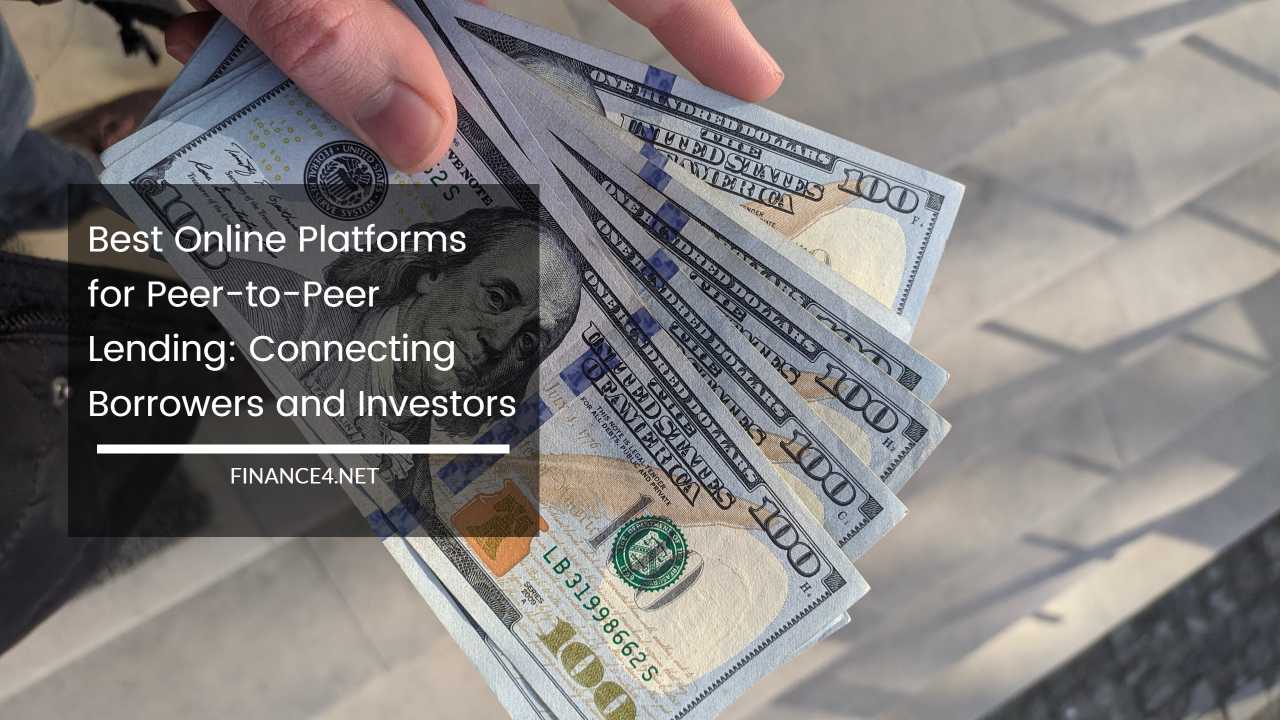Best Online Platforms for Peer-to-Peer Lending: Connecting Borrowers and Investors

Peer-to-Peer Lending
Peer-to-peer (P2P) lending has emerged as a popular alternative to traditional banking and investing, offering borrowers access to funds and providing investors with opportunities for attractive returns.
P2P lending platforms facilitate direct lending between individuals, cutting out the intermediaries and enabling a mutually beneficial financial relationship.
If you are considering participating in P2P lending as either a borrower or an investor, this comprehensive guide will introduce you to the best online platforms for peer-to-peer lending, their features, benefits, and factors to consider when choosing the right platform for your needs.
1. Understanding Peer-to-Peer Lending
Peer-to-peer lending, also known as social lending or crowdfunding, is a form of debt financing that connects individuals seeking loans with investors willing to lend money. P
2P lending platforms serve as intermediaries, providing an online marketplace where borrowers can request loans and investors can fund those loans.
The platform performs credit assessments, determines interest rates, and facilitates loan transactions.
P2P lending benefits both borrowers and investors. Borrowers often find lower interest rates and more straightforward application processes compared to traditional banks, while investors have the opportunity to diversify their portfolios and earn attractive returns.
2. Best Online Platforms for Peer-to-Peer Lending
Several reputable and established P2P lending platforms operate globally, each with its own unique features and offerings. Here are some of the best platforms in the industry:
a) LendingClub:
LendingClub is one of the largest and most well-known P2P lending platforms. It offers personal loans for a variety of purposes, such as debt consolidation, home improvement, and medical expenses.
Investors can choose individual loans or automated investing options based on their risk tolerance and preferences.
b) Prosper:
Prosper is another prominent P2P lending platform that provides personal loans to borrowers. Investors can browse and select loans based on credit grades and loan terms.
Prosper offers a user-friendly interface and tools to help investors diversify their portfolios.
c) Upstart:
Upstart uses artificial intelligence and machine learning to assess borrowers’ creditworthiness.
It focuses on providing personal loans to young professionals and recent graduates. Investors on Upstart can enjoy automated investing options and a relatively low minimum investment.
d) Funding Circle:
Funding Circle is a P2P lending platform that primarily focuses on providing loans to small businesses. Investors can fund small business loans and earn interest on their investments.
Funding Circle’s platform offers transparency and allows investors to review loan details before making decisions.
e) Peerform:
Peerform is a P2P lending platform that caters to borrowers with lower credit scores. It offers personal loans and debt consolidation loans. Investors can choose from a variety of loan categories and diversify their investments accordingly.
f) SoFi:
SoFi started as a student loan refinancing platform and has since expanded to offer personal loans, mortgages, and investment products.
SoFi’s P2P lending platform features competitive rates and additional member benefits for borrowers and investors.
g) StreetShares:
StreetShares specializes in providing P2P loans to small businesses, with a focus on veteran-owned businesses. The platform also offers veteran business grants and lines of credit.
h) Kiva:
Kiva operates as a non-profit P2P lending platform, allowing individuals to lend as little as $25 to entrepreneurs and borrowers in developing countries.
Kiva’s platform aims to create social impact by providing affordable capital to those in need.
3. Benefits of Peer-to-Peer Lending Platforms
a) Easy Access to Financing:
P2P lending platforms offer a straightforward and streamlined application process for borrowers. Borrowers can request loans online and receive funding quickly if approved.
b) Attractive Returns for Investors:
P2P lending can be an appealing investment option for individuals seeking higher returns compared to traditional savings accounts or CDs.
c) Diversification:
Investors can diversify their portfolios by funding loans to a variety of borrowers with different credit profiles.
d) Lower Fees:
P2P lending platforms often have lower fees and expenses compared to traditional financial institutions, benefiting both borrowers and investors.
e) Social Impact:
Some P2P lending platforms, like Kiva, focus on social impact and empower individuals in underserved communities to access affordable financing.
4. Factors to Consider When Choosing a P2P Lending Platform
a) Loan Types:
Consider the types of loans offered by the platform and whether they align with your borrowing or investing needs.
b) Borrower Criteria:
Evaluate the platform’s borrower criteria, including credit score requirements and loan terms.
c) Interest Rates:
Compare the interest rates offered to borrowers and the potential returns for investors on the platform.
d) Fees and Costs:
Review the fees and costs associated with both borrowing and investing on the platform.
e) Investor Protection:
Look for investor protection measures implemented by the platform to mitigate risks, such as loan default.
f) Platform Reputation:
Research the reputation and track record of the platform, including user reviews and ratings.
g) Regulatory Compliance:
Ensure that the platform complies with relevant regulations and provides transparent disclosures to borrowers and investors.
h) Customer Support:
Consider the level of customer support and assistance provided by the platform for both borrowers and investors.
5. Risks of Peer-to-Peer Lending
While P2P lending can be a rewarding experience, it also carries certain risks:
a) Default Risk:
Borrowers may default on their loans, resulting in potential losses for investors.
b) Market Risk:
Changes in economic conditions can impact borrowers’ ability to repay loans and affect investment returns.
c) Regulatory Risk:
Regulatory changes can impact the operations and offerings of P2P lending platforms.
d) Illiquidity:
Unlike publicly traded investments, P2P loans may have limited liquidity, making it challenging to access funds before the loan term ends.
Final Remarks
Peer-to-peer lending platforms have revolutionized the way individuals access financing and invest their money.
For borrowers, P2P lending offers easy access to funds at competitive rates, while investors have the opportunity to diversify their portfolios and seek attractive returns.
By understanding the features, benefits, and risks of the best online platforms for peer-to-peer lending and considering key factors before making a decision, borrowers and investors can participate in this innovative form of lending with confidence.
Frequently Asked Questions (FAQ) – Best Online Platforms for Peer-to-Peer Lending:
Q1: What is peer-to-peer lending (P2P lending)?
A1: Peer-to-peer lending is a lending model where individuals or “peers” can lend money directly to other individuals or small businesses through online platforms, bypassing traditional banks.
Q2: Why consider P2P lending platforms?
A2: P2P lending offers the potential for higher returns compared to traditional savings accounts and provides an opportunity to diversify your investment portfolio.
Q3: How do I get started with P2P lending?
A3: To get started, sign up on a P2P lending platform, complete the necessary identity verification, and deposit funds into your account. Then, browse and select loans or borrowers to lend to.
Q4: Are P2P lending platforms safe and regulated?
A4: Reputable P2P lending platforms are regulated in many countries and follow strict risk assessment and borrower screening processes to minimize defaults. However, there are always inherent risks involved.
Q5: What types of loans are available on P2P lending platforms?
A5: P2P lending platforms offer various types of loans, including personal loans, business loans, real estate loans, and more. You can choose the loan category that aligns with your investment goals.
Q6: How is the interest rate determined on P2P loans?
A6: Interest rates are often determined by factors such as the borrower’s creditworthiness, loan term, and the competitive bidding process among lenders on the platform.
Q7: What are the risks associated with P2P lending?
A7: Risks include borrower defaults, economic downturns, and the lack of insurance on loans. Diversifying your investments and conducting due diligence on borrowers can help mitigate these risks.
Q8: Can I invest in P2P loans with a small amount of money?
A8: Yes, many P2P lending platforms allow you to invest with a relatively small amount, making it accessible to a wide range of investors.
Q9: How can I assess the creditworthiness of borrowers on P2P lending platforms?
A9: P2P lending platforms typically provide information about borrowers’ credit scores, employment history, loan purpose, and financial stability. Review this information to make informed lending decisions.
Q10: What are some popular P2P lending platforms to consider?
A10: Some well-known P2P lending platforms include LendingClub, Prosper, Funding Circle, Zopa, and many others. Research and compare platforms based on your investment criteria.
Before investing in P2P lending, it’s essential to understand the platform’s policies, conduct due diligence on borrowers, and diversify your investments to manage risks effectively.



